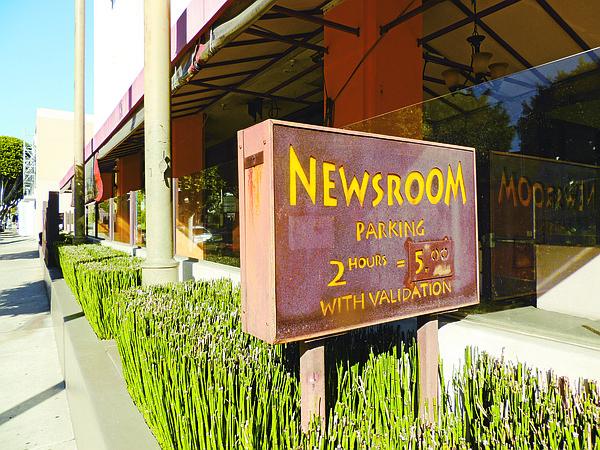OLD SIGN: A sign for Newsroom Café, which closed on Robertson Boulevard in September. The restaurant was an anchor for the street.
RETAIL
Restaurant Could Be the Missing Piece for Robertson Revival
Once the address for the most coveted commercial real estate in Los Angeles, Robertson Boulevard has seen the fashion boutiques move out and move in over the years, but since Newsroom Café, a 7,000-square-foot, emporium-sized restaurant located at 140 N. Robertson, closed in September, some of the street’s businesses are anxious over the prominent thoroughfare’s future.
For Fraser Ross, whose Kitson boutiques serve as an anchor to the street, the restaurant is just one of a string of departures that Ross sees as an exodus from the famed shopping street.
There are at least six boutique-space vacancies on the stretch of Robertson between Third Street and Alden Drive. Alice + Olivia by Stacey Bendet, at 134 S. Robertson, will be closing its boutique on the street in order to move to a much bigger store a mile away.
While The Ivy restaurant, at 113 N. Robertson, remains a key spot for celebrity watching in Los Angeles, and designer stores from Chanel and Ralph Lauren continue to do business on the 100 north block of Robertson, Ross worries that the street is not burgeoning with the opportunity it had in 2000, when he opened Kitson at 115 S. Robertson. Then the street had a heavy presence of multi-brand contemporary boutique retailers.
“I think the street will only survive if it gets a mixture of food and personal-care places like nail and beauty salons,” he said. Ross said he is the biggest tenant in Robertson with more than 15,000 square feet occupied by his multi-brand Kitson, Kitson Men, Kitson Studio and Kitson Kids boutiques as well as office space. The premier stretches of Robertson mostly serve as the address for branded boutiques from high-marquee fashion labels.
Robertson has not kept pace with how the fashion industry has changed, Ross said. When he opened the Kitson flagship, Los Angeles’ retailers and manufacturers made apparel for consumers interested in luxury and celebrity. “When the crash happened, people were a lot more careful with what they bought,” Ross said. “Now service industry and personal care are very important, and serving the customer is very important.”
Jay Luchs, who has served as one of the most prominent real estate brokers to work on the street, said the street is in a transition. “Robertson needs help,” he said. “It will take a year or two, but it will come back stronger than it has in years, no question. It is figuring itself out,” he said. Luchs is an executive vice president of commercial real estate firm NewmarkGrubbKnightFrank.
Some changes may be on the way. There are plans to redevelop the Newsroom area and some adjacent parts of Robertson Plaza, where the restaurant did business for more than two decades, Luchs said. He hopes to bring a high-end destination eatery and café to the former Newsroom space in 2015.
Restaurants are crucial to the success of retail streets, said Carine Mamann, director in the retail-services group for real estate firm Cushman & Wakefield. A great restaurant makes people spend more time on a street. “At its peak, Newsroom was busy all day long with locals and tourists,” Mamann said. “We expect the next restaurant to be even busier.”
Robertson’s popularity skyrocketed in the first decade of the century, particularly between 2004 and 2007, when celebrities such as Paris Hilton and Britney Spears visited the street to shop at multi-brand boutiques and be photographed by paparazzi.
The place drew a lot of interest from high-marquee fashion brands that later opened boutiques on the street. Over time, the street became dominated by branded shops. The Great Recession made business tough on Robertson, as with almost every other street in America, and many independent boutiques moved away from Robertson.
Back in 2007, Ross and other retailers complained that rents were out of control, with the premier blocks of Robertson commanding $17 per square foot. By the time the economy started rebounding, after 2011, other streets such as Abbot Kinney Boulevard in Los Angeles’ Venice neighborhood started vying with Robertson as high-profile fashion streets where fashion-savvy and well-to-do shoppers look for clothes.
Currently, prices for a square foot of retail space range from $14 to $17 per month on Robertson, according to Luchs. The range for prices is around $15 to $16 per square foot monthly on Beverly Boulevard, another upcoming fashion retail street that is growing in importance.






















